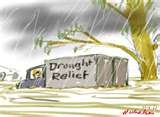Signs of the Times? Drought, Flood & Fire
 Two weeks ago, the weather experts were talking about how 2011 could turn out to be the driest July on record for the Chicago area. Well, driving to work today, I heard the news that July 2011 is now officially the wettest on record!
Two weeks ago, the weather experts were talking about how 2011 could turn out to be the driest July on record for the Chicago area. Well, driving to work today, I heard the news that July 2011 is now officially the wettest on record!
Would Mother Nature please make up her mind?
It’s not like these have been “normal” rains either. They have been torrential rains, often accompanied by strong winds, wild lightning storms, fallen trees, electricity outages and flooding. Four or five inches of water falling in an hour. Nine inches in a 24 hour period. And not just one storm like that, but one storm after another, after another.
And, just like the “heat dome” I discussed earlier, this type of weather has been predicted as one of the by-products of global warming: more frequent, extreme weather events. Violent thunderstorms, massive, long-lived tornadoes, more Category 5 hurricanes.
Other predictions are coming to pass too. As reported by the BBC today, a 1,000 square mile area of Alaskan Arctic tundra burned in the summer of 2007. This was as much tundra as had burned cumulatively since 1950. So, for 57 years, an average of 18 acres of tundra burned each year. Then, in one year, 1,000 acres?
Remember, tundra rarely burns, because it is covered with ice and snow much of the year, and then kind of soggy during the very brief growing season. 2007 was a particularly dry year on the Arctic tundra, so, when a lightning strike ignited the fire in July, it was not extinguished until October when heavy snow snuffed it out.
Now, burning Arctic tundra isn’t like a grass fire, or even a forest fire. The tundra is a type of habitat characterized by a layer of permafrost that can be as deep as 3 feet. Permafrost is an area of the soil that is always frozen. Only the top-most layer of the ground ever thaws – maybe 4-5 inches at the surface – just enough for small plants to grow in the very brief growing season.
Over millenia, this permafrost layer of perpetually frozen soil has served as a place where atmospheric carbon (CO2) was stored (sequestered). That is no longer the case, however. When permafrost actually dries out due to a combination of longer periods of time without snow cover and drier weather conditions, this previously stored carbon is released into the atmosphere again. Toss a fire on top of that, and the release of carbon is accelerated that much more.
In fact, while the tundra region was once considered a place where there was net storage of carbon each year, today it is a net releaser of carbon each year. Actually, release of carbon & methane, both so-called “greenhouse” gases because of the way they collect in the atmosphere and help to magnify the warming effects of the sun.
If you are like me at all, you are now thinking “Gee, thanks for that depressing bit of information that I can’t do anything about!”
But that’s when we need to pick ourselves up and change our thinking. We may not be able to directly stop the burning tundra, but each of us can surely start making decisions that will at least contribute in some small way to slowing the global forces that are accelerating around us.
My favorite quote ever is from Gandhi. It hangs on my wall. “Be the change you wish to see in the world.” Do what you can. Lead by example. Do it now.